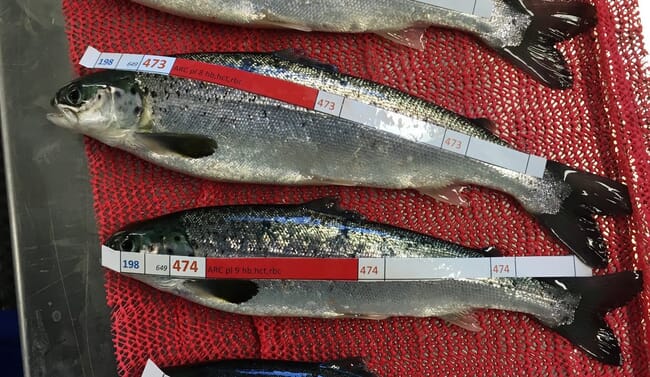
© Kaja Skjærven, IMR
Small epigenetic tags can attach themselves to genes during an organism’s life, locking in environmental influences on how genes are expressed. Specific tags can also be passed on from parents to the next generation, thereby affecting the inheritance of characteristic traits (phenotypes).
Researchers from IMR in Norway were inspired to investigate this in fish, after reading a study about how the nutrition of a mother mouse determines the weight of her offspring.
“Fascinated by that result, we began to investigate whether the phenotypes of fish are also influenced epigenetically by the feed they are given,” they explain in a press release.
“This is of great importance in aquaculture, as the tags may either stimulate the development of beneficial traits or may possibly hinder the development of robust fish,” the researchers add.
They initially used zebrafish to test whether the feed had an impact on their offspring. In one experiment, they gave the parent fish a feed with low vitamin B content, whereas the offspring received sufficient vitamin B. They then compared them with a control group where both the parents and offspring received sufficient vitamin B.
When the offspring had reached adulthood, the researchers examined their livers more closely.
“The first thing we noticed was that the experimental group had lighter-coloured livers than the control group. More detailed investigation revealed that the liver cells contained more fat, which is associated with poor health,” they explained.
“Moreover, analysis showed that genes involved in fat regulation were used differently by the two groups,” added the researchers.
Thousands of tags on the offspring’s DNA had been changed by the quantity of vitamin B in the feed consumed by the parents.
“This was the first result to verify that fish feed can affect the health through epigenetics of fish offspring, either through changes in inherited tags on DNA or through the nutrients allocated in the yolk sac,” they say.
“The result indicates a possibility for the aquaculture industry to epigenetically control the phenotype of the fish it produces, ensuring that the parents’ feed doesn’t become an old habit that dies hard in their offspring,” they conclude.
Since then, the researchers have completed a research project on salmon in which they addressed four epigenetic questions that are relevant to the aquaculture industry.
The first was whether the tags and the way in which genes were used were influenced by the ingredients in the feed given to salmon.
It turned out that the micronutrients in the feed can directly affect the tags in a dose-dependent manner. This was particularly true of genes that play a key role in fat regulation.
If the ingredients in the feed do not meet the needs of the fish, the tags can weaken their health.
Epigenetic preparation of pre-smolts
The second matter they investigated was whether the micronutrients in feed affect growth during smoltification by regulating epigenetic tags which regulated which genes are expressed.
Once again we observed that the feed affected how the genes were used prior to smoltification. But the impact was greater three months after smoltification, while growth during the post-smolt stage was improved.
These results showed that the feed given at the pre-smolt stage may provide the basis for successful smoltification. The results relating to the epigenetic tags will be published later this year.
“For the aquaculture industry, the environmental conditions in which pre-smolts are kept may be of vital importance. If the environmental conditions are not favourable, the tags may become an old habit that dies hard regardless of how they are treated during the post-smolt stage,” the researchers explain.
The influence of spawning
The third issue studied was whether the timing of spawning in salmon could affect their offspring.
Preliminary results show that micronutrient levels in eggs varied, depending on the timing of the spawning season. The results suggest that the foundations for various phenotypes are conferred through “inheritance” from the mother.
“Inheritance” includes both inherited tags on the mother’s DNA and the influence through the contents of the yolk sac, including micronutrient levels. The broodstock’s genetic material in the various spawning seasons investigated here originated from the same broodstock line, and all eggs were fertilized by the same father.
For the aquaculture industry, there is a possibility for adjusting the environmental factors (nutrition, feeding regimes, nutrient status, temperature and light) that broodstock are exposed to in order to fine-tune the epigenetic tags in the offspring and thereby alter specific traits (phenotypes).
Is there epigenetic inheritance from the father?
In several model organisms, it has been found that the inherited tags of the father can also be passed on to offspring.
"We have started by analysing whether the broodstock father’s nutrition can affect the epigenetic tags in the tissue containing the DNA that will be passed on to the next generation. The results showed that the tags on DNA in gonadal tissue is also highly sensitive to the broodstock father’s nutrition," they say.
“It is not yet known whether these tags are passed on to the next generation, but based on research involving other model organisms, we would expect so.From the above, it is clear that epigenetic research is of great relevance to the aquaculture industry. Amongst other things, it can uncover the ways in which fish farmers can best adapt their fish to life in a cage by adjusting the inherited tags, so that the old habits of their broodstock mothers and/or fathers don’t die hard in the offspring,” the researchers conclude.



